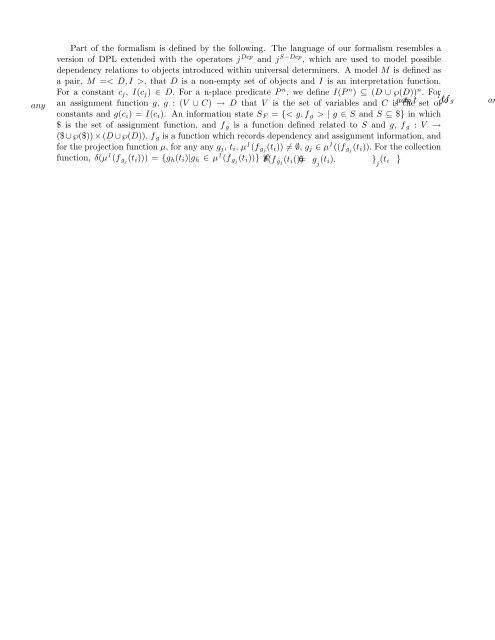SemPrag03.Progr.pdf - Institut für Linguistik/Germanistik - Universität ...
SemPrag03.Progr.pdf - Institut für Linguistik/Germanistik - Universität ...
SemPrag03.Progr.pdf - Institut für Linguistik/Germanistik - Universität ...
You also want an ePaper? Increase the reach of your titles
YUMPU automatically turns print PDFs into web optimized ePapers that Google loves.
Part of the formalism is defined by the following. The language of our formalism resembles a<br />
version of DPL extended with the operators j Dep and j S−Dep , which are used to model possible<br />
dependency relations to objects introduced within universal determiners. A model M is defined as<br />
a pair, M =< D, I >, that D is a non-empty set of objects and I is an interpretation function.<br />
For a constant c j , I(c j ) ∈ D. For a n-place predicate P n , we define I(P n ) ⊆ (D ∪ ℘(D)) n . For<br />
an assignment function g, g : (V ∪ C) → D that V is the set of variables and C is the set of<br />
constants and g(c i ) = I(c i ). An information state S F = {< g, f g > | g ∈ S and S ⊆ $} in which<br />
$ is the set of assignment function, and f g is a function defined related to S and g, f g : V →<br />
($ ∪ ℘($)) × (D ∪ ℘(D)). f g is a function which records dependency and assignment information, and<br />
for the projection function µ, for any any g j , t i , µ 1 (f gj (t i )) ≠ ∅, g j ∈ µ 1 ((f gj (t i )). For the collection<br />
function, δ(µ 1 (f gj (t i ))) = {g h (t i )|g h ∈ µ 1 (f gj (t i ))} if

















